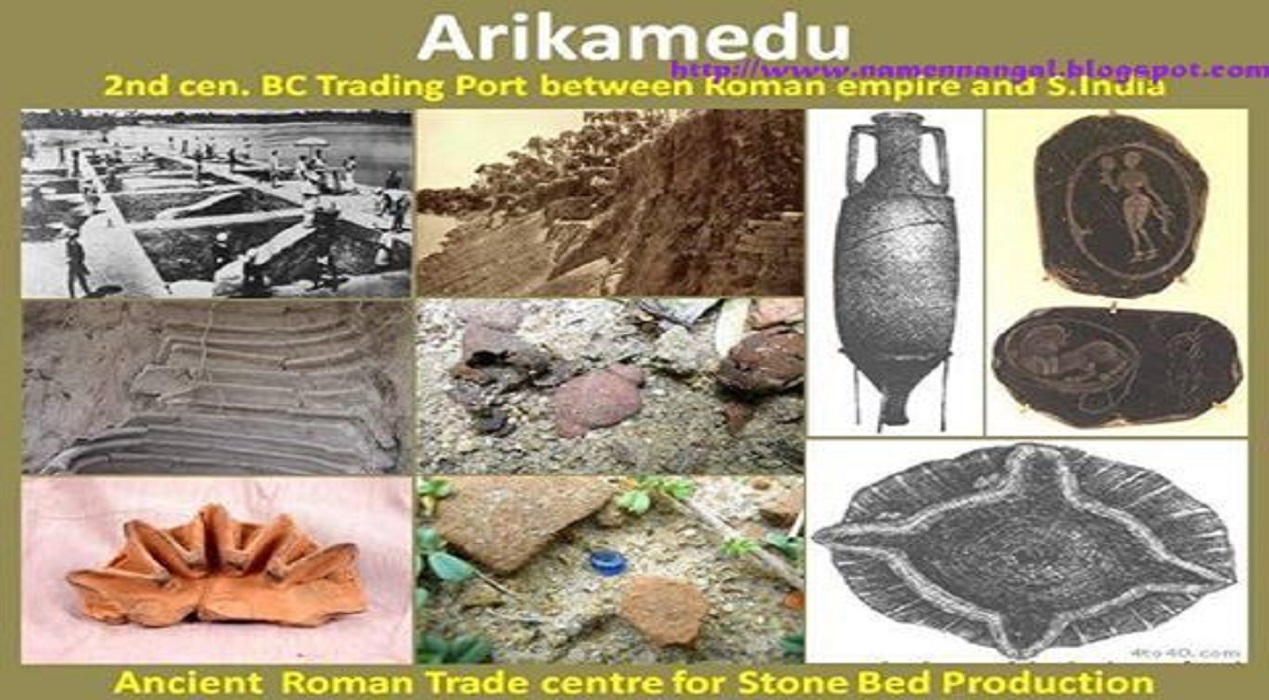The Indian subcontinent was largely colonised by the British Empire for almost two centuries and an official establishment for archaeology was introduced by Alexander Cunningham, a British army engineer. He was the founder of the Indian Archaeological Survey and Director of Survey until 1885.[1] The focus of a lot of sites tended to bend towards the Greek and Roman influences over the Indian subcontinent. This slight bias led to some local cultures being overlooked in some sites and emphasis was shifted towards the Indo-Greek or Indo-Roman factor of the site. While there are multiple instances exhibiting these issues, one of the most appropriate examples would be the site of Arikamedu, Tamil Nadu.
Arikamedu also known as Poduke is a coastal port site in Tamil Nadu in the south-eastern coast of India and this site is well known for its history of trade in ancient India. The site is 4km from Pondicherry and is on the coast of the river Ariyankuppam. The site is most popularly known as a Roman port site in the south of the subcontinent. It was first excavated and researched by Sir Mortimer Wheeler in the year 1945. Initially the site in question was researched with a colonial mindset and was declared as a Roman port. While this allowed the researchers and the archaeologists working on similar sites to come up with a basic chronology for the site, this site was declared to be a trading station which was active from 2nd century CE by Wheeler. This chronology has been the basis for establishing the timeline for several other similar port sites around this region and to determine the onset of the South Indian trade with the Mediterranean region.[2] Further research and excavations led by Vimala Begley from 1989- 92, revealed that the site existed before the arrival of the Romans during the first two centuries CE. The site dates back to the 2nd century BCE, which was during the rule of the Mauryan Empire in India. Revisiting this site with a post-colonial approach led to the discovery of the earlier origins of the site and gave a new insight towards the site, its history and the role it played in the trade interactions with the Mediterranean region.
The Mauryan Empire had a vast reach throughout the Indian Subcontinent. The empire was founded by Chandragupta Maurya (305 BCE- 298 BCE) and was later expanded by his son and grandson Bindusara (320 BCE- 272 BCE) and Asoka (272 BCE- 232 BCE) respectively.[3] As the dates for the site of Arikamedu were revised to 2nd century BCE it shows that the site was participating in active trade before the suggested Roman period. While the majority of the Indian Subcontinent was under the flourishing rule of the Mauryan Empire the southern tip was ruled by small independent rulers which later developed into various kingdoms in the coming centuries.[4]
The initial approach adopted with the site, by Wheeler was a cultural historical approach, which was no doubt quite advantageous in providing a suitable chronology and helped in categorizing all the available material culture excavated at the time. The chronological sequence of the site was divided into two periods, that is, Megalithic period and Roman period. And the main reasons behind this divide were the amphorae, terra sigillata and the Rouletted ware found from the site. Amphorae is a type of pottery which is typical for the movement of goods in the Mediterranean region whereas, terra sigillata is typically Roman in nature. These particular finds led to the conclusion of the site being a Roman trading centre in the first place and lead to the misidentification of the origin of the Rouletted ware and it was classified as Roman. This made it easier for the archaeologists working on the sites along the same river estuaries as it gave them a chronological sequence to follow and compare. Even though following this particular approach helped in uncovering a lot of data with appropriate results it is important to keep in mind that the data recovered which did not fit into the criteria of the sequences was ignored and was not researched thereafter. And as the other similar sites were being looked at while keeping the chronology of this site it was erroneous because of which a lot of data was either misinterpreted or ignored altogether.
Pottery is the essence of majority of archaeological studies as it not only helps in understanding the culture of the region under investigation but also helps in dating the various activities taking place over a series of different time periods. Dating through the different types of pottery comes under relative dating which though not accurate in nature, it still helps on giving a specific time period to any particular region. Accurate dating can also be done through pottery but the most popular method used to date is through typology. Certain types of potteries were only created in a specific time period or under the rule of a specific kingdom. As discussed above the types of pottery found at Arikamedu were specific to the Mediterranean region and pottery such as Terra sigillata have quite specific date (1st century BCE to 3rd century CE).
The colonial approach was one of the reasons why the presence of the Rouletted ware which preceded the import of Mediterranean amphorae and Roman Terra sigillata was not given much emphasis at the time. Some pottery shards were also found with Brahmi script which was introduced in Tamil Nadu at the time of the Mauryan EmperorAsoka.[5] “The Rouletted ware was found in the Mauryan cultural sequence along with some brick remains which were earlier established as constructions made by the Romans. Wheeler and Casal maintained that the finer varieties of Rouletted ware were imported to Arikamedu from the West. Wheeler even suggested that the pottery was derived from Arretine ware while Casal points out similarities with earlier Mediterranean types. But it should be stressed that, except for the technique of “rouletting”, no precise parallels for fabric and shape can as yet be found” (Begley. 1983).[6] This particular quote goes on to show the deeply entrenched post-colonial roots of practicing archaeology in modern day India and while some changes have taken place in these approaches over time, there is still heavy colonial influence on how archaeology is practiced in the Indian Subcontinent. While this is one of the factors affecting the current studies of ancient trade networks in India, there are several other factors because of which this field of study needs to be further researched with new perspectives. The above-mentioned quote shows that the manufacturing centre of these Rouletted wares are unknown. The technique was introduced from the Mediterranean region in South India but there is a strong possibility that the shape and fabric are wholly localised and not all of these remains were imported from the Mediterranean region. There are also some drawbacks to this approach and the most crucial one is the focus is so much on looking for imports from the Mediterranean region instead of focussing on the production of the local material culture.
“The colonialist usually say that it was they who brought us into history: today we show that this is not so. They made us leave history, our history, to follow them, right at the back, to follow the progress of their history” (Cabral. 1974).[7]
The above-mentioned sentiments are some which are largely echoed by a majority of post-colonial nations. This shows that studying our country’s heritage by focussing on its post-colonial aspects is one of the most relevant needs of the hour. This need arose due to the repercussions of the colonial rule over the subcontinent that is not taken into account while discussing the country’s present as well as future. This makes it crucial to re-examine these old studies and integrate it with the current work to form a far-reaching understanding of this field, to shed some of the preconceived colonial notions and view the data with fresh perspectives.
[1]Abu Imam, Sir Alexander Cunningham (1814-1893): The First Phase of Indian Archaeology. The Journal of the Royal Asiatic Society of Great Britain and Ireland. No.3/4, 1963, Pp. 194-207. [4] VimlaBegley, The Ancient Port of Arikamedu: New Excavations and Researches, 1989-1992, Vol. 2, Centre d'histoire et d'archéologie, École française d'Extrême-Orient, 1996, Pp. 1- 15. [5]Vimala Begley, American Journal of Archaeology. Rouletted Ware at Arikamedu: A New Approach. Vol. 92. No. 3, 1988, Pp. 427-440. (The paper is the author’s individual scholastic articulation. The author certifies that the article/paper is original in content, unpublished and it has not been submitted for publication/web upload elsewhere, and that the facts and figures quoted are duly referenced, as needed, and are believed to be correct). (The paper does not necessarily represent the organisational stance... More >>
[2]Vimala Begley, American Journal of Archaeology. Arikamedu Reconsidered. Vol. 87, 1983, Pp. 461-481.
[3]Manjulal RanchholdlalMajmudar, (Ed.). (1960), Historical and cultural chronology of Gujarat. Vol. 1, Maharaja Sayajirao University of Baroda, 1960.
[6]Vimala Begley, American Journal of Archaeology. Arikamedu Reconsidered. Vol. 87, 1983, Pp. 461-481.
[7]Amilcar Cabral, Return to the Source. NYU Press, 197
Image Source: https://4.bp.blogspot.com/-CAAq-H9Gd0I/VyAP4sqWZ-I/AAAAAAAAAkI/DGy2Bz8xitA-fLOYmz2u-fbWwlCM5RaJgCKgB/s640/arikamedu.jpg











Post new comment